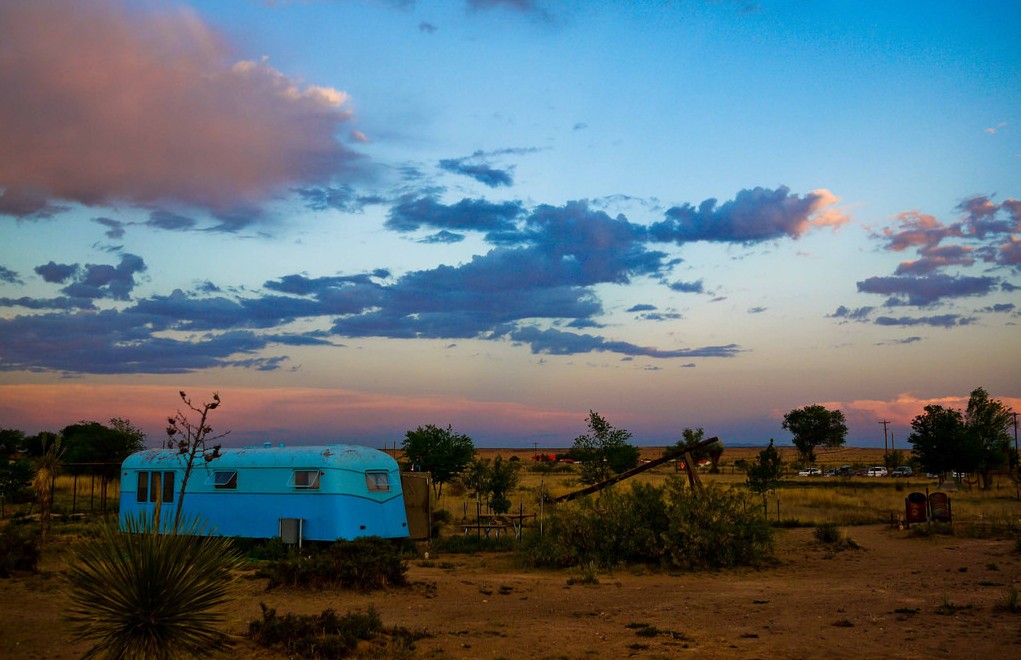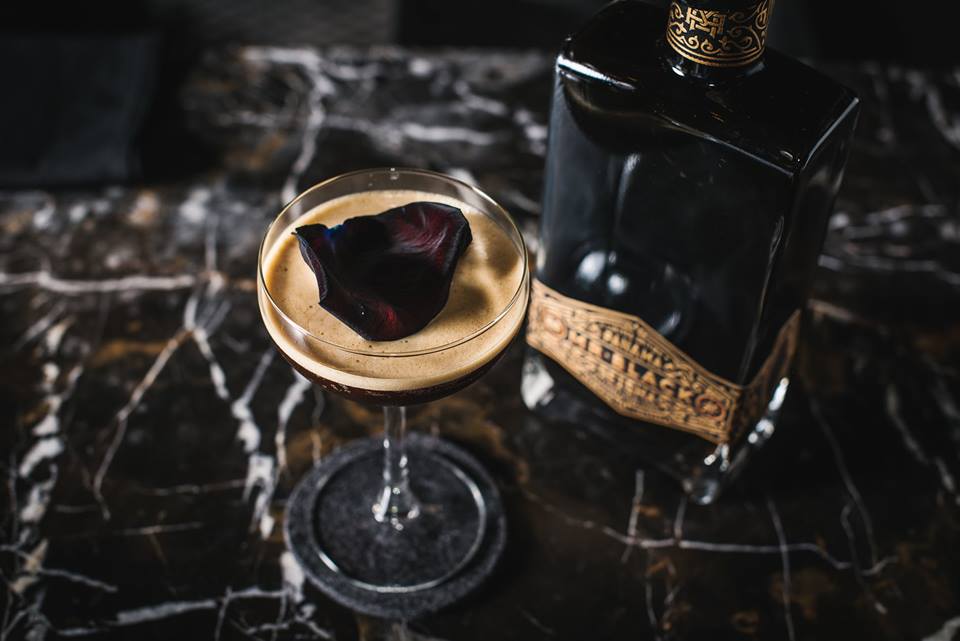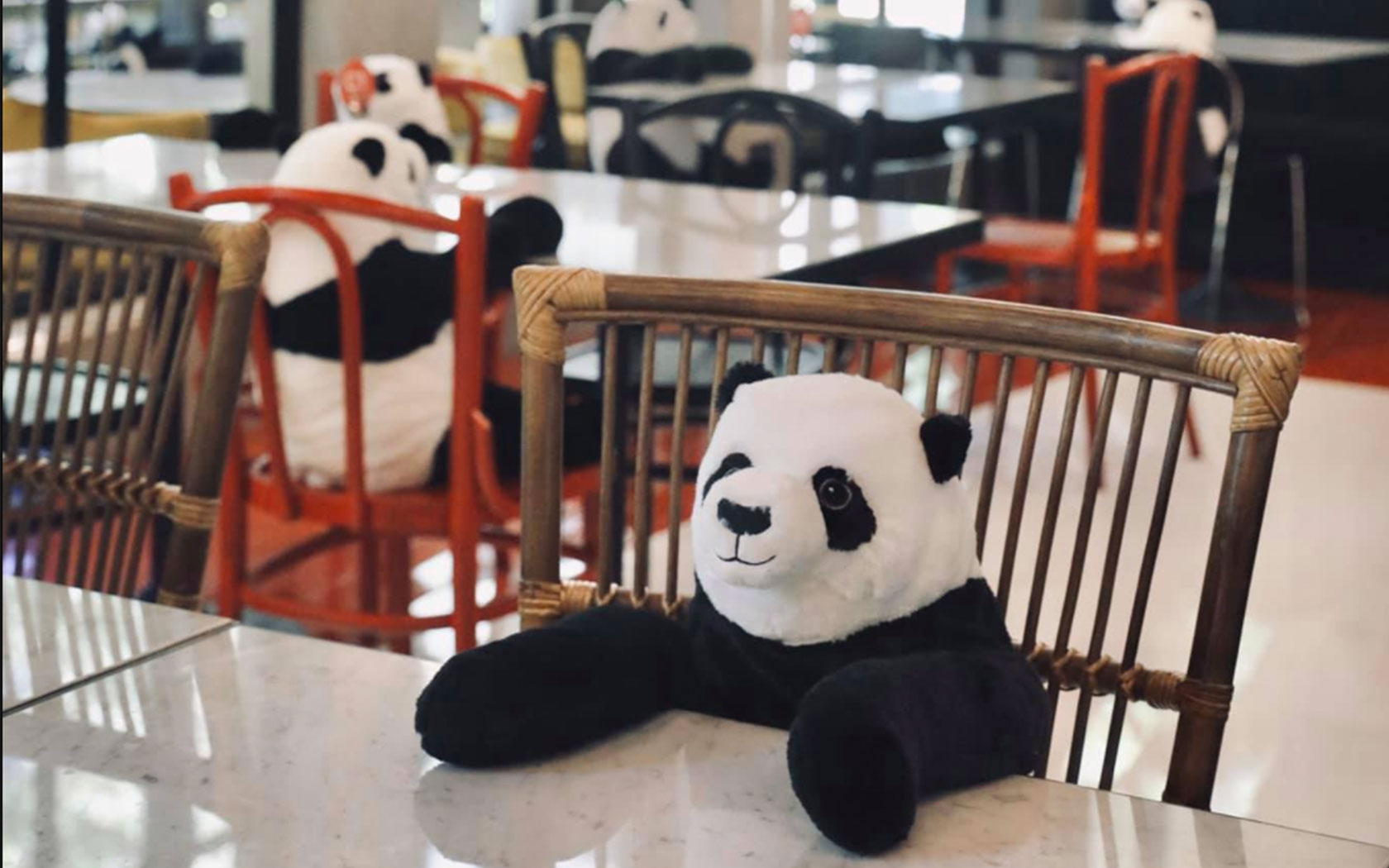A 48-Hour Fever Dream I Had In Marfa, Texas

Simone Ubaldi is a ghostwriter, music journalist, film critic and…
Marfa, west Texas. We are in the middle of nowhere. We are 80 kilometres from the Mexican border and three hour’s drive from El Paso. Three hours drive from Odessa, too, which has the closest airport. Odessa is a little oil town on the Mexican-American trade route but it’s a heaving metropolis compared to Marfa, TX (population 2000).
This was a thing that happened, a few years ago now, and the details are sketchy. It was an impulse on the back of an impulse; a quick trip down to Austin for the Austin City Limits Festival and then maybe, yeah, let’s head out west to the Trans-Pecos desert. Let’s gas the tank and buy some beef jerky for the road. We heard there’s art out there.
The shark on main street
The Marfa water tower dominates the sky, a bulbous steel arthropod rising high over dusty, low lying streets. This is what we see as we roll into town, the remnants of railroad history. Marfa was founded as a water stop for the Southern Pacific Railroad and named by the wife of a railroad official, after a character in The Brothers Karamazov.
We drive in from the north, following Highway 17 through the green foothills of the Davis Mountains, past the water tower towards Highland Avenue, which is Marfa’s main street. At one end of Highland, the Presidio Courthouse looms all white and regal, but the rest is squat, plain and etched in dust. We cross the old railway line, which cuts right through town, and turn the car towards a rest stop on the wrong side of the tracks. There is a vast steel pergola overhead, a collection of picnic tables underneath, and a gleaming silver food truck standing lone in the distance.
As far as we can tell, the Food Shark is Marfa’s only food truck, however it has been named one of the ’12 Best Lunch Trucks Across America’ and has featured in The New York Times and USA Today. Relative to the air of sun-baked desolation that wafts down the main street, this truck is party central. It feels like there are 20 people in town, total, and they are all here ordering a casual lunch.

Through the window of the truck, a moustachioed hipster named Adam Bork is taking orders. Adam is the Food Shark’s “art director.” He has a wide and friendly face. He’s dressed for work, but he gives off a distinct Hawaiian shirt/vintage sunglasses vibe. In the back of the truck, Adam’s wife Krista is making falafel. The Food Shark menu rotates daily, but her Marfafalafel is a local favourite. It has also been written up in Forbes Magazine.
We learn later that Adam and Krista are minor celebrities in Marfa, transplanted from Austin in the early 2000s. In addition to selling falafel, Bork moonlights as the proprietor of Marfa’s Museum of Electronic Wonders and Late Night Grilled Cheese Parlour. He is also an artist. One of his recent works, the Art Elimination Project, involved blowing up artworks that he had previously created.
Krista’s falafel is excellent.
Nowheresville, TX
In the early part of the 20th century, Marfa thrived as a military town. Military men patrolled the Rio Grande from Camp Marfa, later renamed Fort D.A. Russell, to patrol the US-Mexico border. The Marfa Army Airfield was built alongside the base in 1942 and POWs were shipped in for some extended Texan hospitality while pilots were shipped out to fight the Germans on home soil.
After the war, the airfield and the army base closed and the town crumbled into dust. James Dean and Elizabeth Taylor shot Giant in Marfa in 1956, but otherwise the decades passed unremarkably. It was Nowheresville, Texas, a blip on the map. Then Donald Judd came to town.

Judd was one of the major American artists of the 20th century, a leading Minimalist sculptor. A New York native, but notoriously difficult and taciturn, he moved to Marfa in 1971; it was as far from the East Coast as he could get without stumbling into California. Within a decade, in love with the desert, Judd bought the abandoned Fort D.A. Russell with a grand vision for its future. The old military base would become a gallery for works by Judd and his friends.
Judd’s gallery, called The Chinati Foundation, opened in 1986. Over the preceding decades, the far west dustbowl he had adopted became a destination for art lovers, and Marfa went from Nowheresville to a town like nowhere else.
Trans-Pecos style
We want to stay in an Airstream at El Cosmico, Marfa’s hip trailer park on the south edge of town, but El Cosmico is hosting the Trans Pecos Festival of Music and Love that weekend and they are no vacancies. We end up at the Thunderbird Hotel on West San Antonio Street, which has its own stylish reputation. The Thunderbird is a renovated ’50s roadside motel built around an in-ground pool, which from the outside looks like a Route 66 classic. Inside, the rooms are mid-century cool, all wood, cement and white surfaces.
We want to stop. We want to lie like lizards in the lazy-boys by the pool, drink beer and feel the desert air on our skin, but this is a short trip, tick tock, and there’s this thing we have to see. Heading west out of town on Highway 90 we pass a satellite village called Valentine – a wrecked, desolate, economically depressed community that makes Marfa seem like Los Angeles – and few miles beyond Valentine, this thing comes into view.

Prada Marfa is a small adobe building, painted white, that sits like a sore thumb on the edge of a desert plain, framed by nothing but crab grass and mountains. Created by artists Michael Elmgreen and Ingar Dragset, it is a minimalist replica of Prada store. The wide windows showcase real Prada shoes and handbags, out here in the middle of nowhere. There is a legitimate Prada logo embedded over the awnings and red desert dust on the door.
We jump out of the car and circle the building, peering through the windows. Prada Marfa is jarring and funny, out here on the prairie; incredible because, like much of Marfa, it shouldn’t be here at all. We are leagues from Prada’s target demographic, miles from anywhere at all.
Back in Marfa proper, we are devastated to learn that the Museum of Electronic Wonders & Late Night Grilled Cheese Parlour is only open on the weekend. We peer through a dusty window on West San Antonio Street at Adam’s bar, which holds Adam’s collection of vintage televisions, on which you can play vintage video games while eating freshly toasted sandwiches, but only on a Friday or Saturday.
On the other side of Highland, at a dive bar called the Lost Horse Saloon, we fall into conversation with a girl from the Midwest who is waiting for Marfa to pop. “It’s comin’, you know. Marfa is like to new Portland, or whatever. But it’s comin’ slow.” She tells us about the fine roster of bands that make their way through this far-flung locale. Austin favourites like The Black Angels and The Heartless Bastards pass through regularly, but musicians from all over the place are drawn to the weirdness here. Bonnie Prince Billy, Bon Iver, Yeasayer, Grizzly Bear, Ty Seagall, Sonic Youth, Joanna Newsome, Animal Collective – they’ve all played or recorded at Ballroom Marfa, an art place in the middle of town.
“Oh hey, are you guys staying for festival?” our friend asks suddenly. El Cosmico’s festival of music and love starts in two days, we’re due to leave in one. “Trust me, you gotta stay!” she smiles, winking at us over her beer.
Concrete and glow sticks

The next day, we visit Chinati. The foundation is on the southern edge of town and there is some confusion about the roads, but we know we’re in the right place when the boxes come into view. Sitting brute and tall in the yellow grass is 15 untitled works in concrete – a series of hollow cubes made from heavy slabs, arranged in a graceful line along the east side of the property. These boxes are a sculptural work by Donald Judd and they are as strange as Prada Marfa, in a way. They are out of place, but in their weight and scale, a perfect mirror of the desert. For some reason, the concrete boxes draw you eye towards the sky, and the sky in Texas rolls into forever.
Chinati is a ghost town. The art is housed in the abandoned structures of Fort D.A. Russell – stocky buildings that squint at far off mountains, connected by dirt paths and dust. Laid out on a concrete slab that was once a military tennis court, we find three concentric circles built from black volcanic rock. They were carried to Marfa from Iceland by the artist Richard Long. In a low building that huddles around an overgrown courtyard, we find the crumbling remains of a Russian schoolhouse created by Ilya Kabakov. It’s rooms are filled with strange memories, broken furniture and tumbleweeds, and they are slowly succumbing to the earth.
Judd has installed another epic piece in the old artillery sheds, 100 untitled works in mill aluminium. These silver boxes run in perfect rows along the polished concrete floor, reflecting desert light through the floor-to-ceiling windows. Our palms itch, but if we touch the brushed silver surfaces, our fingerprints will stay. Through the window we see a giant horseshoe jutting into the sky – a sculpture that Claes Oldenburg has left behind.

Chinati is a living art foundation; the exhibitions are permanent. Each work was chosen for the way it interacts with the surrounding desert and each work is a silent witness to the slow passage of time. There is a lot of steel, concrete and stone, which complements the hard edges of Texas, but in this context Dan Flavin’s work is like a futuristic dream. In six disused army barracks, lined up side-by-side, Flavin has installed fluorescent light sculptures and bent the walls to his will. Purple, green and orange bars of light throw intense fields of colour on the white washed surfaces, which connect to the ceiling at violent angles. The rooms are beautiful, intense, but the real trick comes when we walk outside, down the dirt path and and through another door. Moving from the outside to the inside world is like flipping between Fort D.A. Russell and Mars.
Unexplained phenomena
We visit El Paisano that evening, a restored ’30s hotel that is on the National Register of Historic Landmarks, which housed James Dean, Rock Hudson and Elizabeth Taylor when they were shooting in town. It’s up on Highland near the Courthouse, surrounded by art galleries, with a cute little gift shop out front and a quiet patio under the stars. It’s here we sit and order beer, killing time beside the hotel fountain. The Trans Pecos Festival starts the next day and we’ve decided to stay, on the advice of literally everyone in town.
Halfway through our beer we realise that Robert Plant is sitting at the table beside us, wearing plaid shorts and a pair of flip-flops. It’s probably definitely Robert Plant of Led Zeppelin and not just a guy who looks like Robert Plant who coincidentally has a British accent. The flip-flops are a mystery.

Later that night, we drive east on Highway 67 to the Marfa Lights Viewing Center, a platform out on the Mitchell Flat built for fans of unexplained phenomena. We have more beer, in cans, purchased from Marfa’s organic hipster minimart, known as The Get Go, and we are determined to get drunk enough to see the infamous ghost lights. Observed once or twice a year on this lonely stretch of road, the lights appear as glowing orbs that dance above the horizon, sometimes blue, sometimes yellow, sometimes zipping across the sky. We sit on the bonnet and stare hard into the distance, seeing nothing but dark prairie. This is disappointing, but what can you do. If the truth is out there it’s leaving us alone.
Probably definitely only in Marfa
The same girl who serves us breakfast on our last day in Marfa turns up behind the counter of Fancy Pony Land, a quirky clothing store on East San Antonio inspired by ‘animals, birds and the natural world.’ We mention that we’ve seen the same faces in a few different places in town. “You’re not imagining things,” she laughs. Most people hold down a couple of jobs, she explains. Not enough hipsters to go around.
We debate driving out to Big Bend National Park but it’s two hours away at least and the sun is brutal. We wander the main street instead, and cruise the sandy back roads, sipping iced tea and looking for something we’ve missed. The thing about Marfa, there isn’t much to it. It’s empty and fumbling on the edge of America. Except there are these parts that aren’t, that don’t, that led us into the desert.

The Trans Pecos Festival or Music and Love kicks off in the afternoon and we head down to eat tacos and cruise the market stalls, buying a tie-dyed poncho and a pair of cowboy boots. Neither of these things will make sense outside of Texas. As the sun goes down, the crowd swells to a dizzying peak of maybe 300 people, comprising families and older folk, and a bunch of beer-blasted kids.
A spacious cluster of music fans gathers around the stage but many remain seated in picnic chairs at the back of the clearing, chatting idly about local concerns as night falls. Folk artist Patty Griffin is the headline act that night and she comes out with a full band and her boyfriend in tow, and it turns out Patty’s boyfriend is Led Zeppelin’s Robert Plant. Plant has blonde and grey curls cascading over a black turtleneck and a microphone in hand, and he has swapped the plaid shorts for a respectable pair of jeans. It’s probably definitely Robert Plant. They do a bunch of blues numbers and in addition to sounding like the lead singer of Led Zeppelin, the guy on stage leans back and crosses his legs in a distinctive Led Zeppelin-ish fashion. He also introduces himself as Robert Plant. He and Patty sing country versions of Zeppelin classics including Rock & Roll, Black Dog and Misty Mountain Hop, but Robert’s voice is kind of shot so Patty takes the high parts.
We’re having some difficulty processing what is happening here. Most if not all of the Trans Pecos ticket holders are on their feet now, yet the crowd remains thin and ramshackle. We are standing in the dirt in a trailer park with a few hundred locals, whooping at a guy in a turtleneck who coincidentally changed the course of music in the 20th century. You wouldn’t think twice about it in New York. It’s bizarre because we’re in Marfa. But actually, in a way, it makes perfect sense. Where else would it happen but here?
(Lead image: Paul Joseph/Flickr)
[qantas_widget code=SAT]Marfa is a six hour drive from San Antonio, Texas. Fly there with Qantas.[/qantas_widget]Simone Ubaldi is a ghostwriter, music journalist, film critic and frequent flyer. She has written for The Age, The Monthly, triple j Mag, Paper Sea, Faster Louder and various other publications, and appeared on ABC Radio National, triple j and Melbourne's 3RRR FM. She has co-authored four books, including memoirs of Bon Scott and Mark 'Chopper' Read, and she stashes a lot of her writing here.








